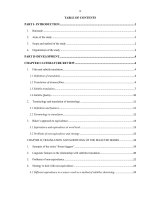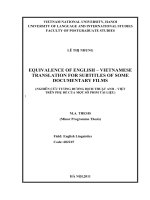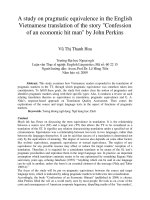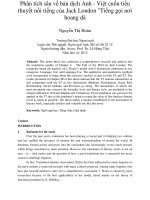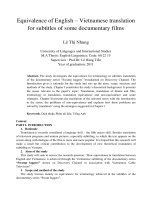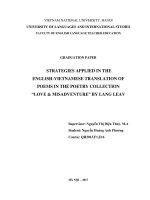Equivalence of English – Vietnamese translation for subtitles of some documentary films
Bạn đang xem bản rút gọn của tài liệu. Xem và tải ngay bản đầy đủ của tài liệu tại đây (246.66 KB, 9 trang )
Equivalence of English – Vietnamese translation
for subtitles of some documentary films
Lê Thị Nhung
University of Languages and International Studies
M.A Thesis: English Linguistics; Code: 60 22 15
Supervisor : Prof.Dr. Lê Hùng Tiến
Year of graduation: 2011
Abstract. The study investigates the equivalence for terminology in subtitles translation
of the documentary series “Swamp loggers” broadcasted on Discovery Channel. The
Introduction gives a rationale for the study and sets up the aims, scope, structure and
methods of the study. Chapter I constitutes the study’s theoretical background. It presents
the issues relevant to the paper’s topic: Translation, translation of drama and film,
terminology in translation, translation equivalence and non-equivalence and some
strategies. Chapter II presents the translation of the selected series with the introduction
to the series, the problems of non-equivalence and explains how these problems are
solved by translators’ using the strategies suggested in Chapter I.
Keywords. Dịch thuật; Phim tài liệu; Tiếng Anh
Content
PART I- INTRODUCTION
1. Rationale
Translation is recently considered a language skill – the fifth macro skill. Besides translation
of television programs and motion pictures, especially subtitling, in which the text appears on the
screen along with dialogue of the film is more and more popular. It is hoped that this research will
make a small but critical contribution to the development of new theoretical foundation of
subtitling in Vietnam.
2. Aims of the study
This study will seek to answer the research question: "How equivalence in translation between
English and Vietnamese is achieved through the Vietnamese subtitling of the documentary series
“Swamp loggers” shown on Discovery Channel in association with Vietnamese Cable
Television?"
3. Scope and method of the study
The study focuses mainly on equivalence for terminology achieved in the subtitles of the
documentary series “Swam loggers”.
The evaluation of equivalence will be based on the approach suggested by Baker (1992) using
a list of the two texts: the source text and the translated version.
4. Organization of the study
The study consists of three parts:
Part I is the Introduction which describes the reasons for the choice of the topic, the aims, the
scope, method and organization of the study.
Part II is the Development with Chapter I providing the literature review of translation,
terminology and equivalence; Chapter II giving the synopsis as well as subtitling of the selected
series; the problems of non-equivalence and subtitlers’ strategies to deal with those problems.
Part III is the Conclusion and suggestion for further study.
PART II-DEVELOPMENT
CHAPTER I: LITERATURE REVIEW
1. Film and subtitle translation
1.1 Definition of translation
Translation is a variedly defined concept that has caused vigorous debate along its
development history. Finding the closet equivalence while maintaining “style” and “meaning” as
authentic as possible determines the authenticity of the translation in grammar, culture,
comprehension, and message content. To have a deeper investigation into equivalence, film
subtitles translation will be discussed in this research paper.
1.2 Translation of dramas/films
Translators of drama have discomfort in having dramatic text, with emphasis on verbs, rather
than that of more descriptive and explanatory. Therefore a translation of a drama must be concise
– it must not be an over-translation.
1.3 Subtitle translation
Subtitles, according to Baker, M. (Ed.) (1998) are “transcriptions of film or TV dialogue,
presented simultaneously on the screen.” She also highlights the “authenticity” gained in subtitles,
which includes the real voice quality and intonation of the actors. A more detailed view of
subtitling in Vietnam can be seen in Appendix I – Subtitling instruction by Qnet Entertainment
1.4 Subtitle Quality
According to James (2001), subtitles quality is to meet clients’ expectation. “Clients” here are
the producer,the author/scripts writer expects his or her intention to be reflected accurately and
authentically” in the translated subtitles (James 2001:152). Accuracy, clearness, credibility and
consistency with the action on the screen are what to expect in subtitles. Moreover, subtitles are
evaluated by the quality of translation and quality of typo accuracy.
2. Terminology and translation of terminology
2.1 Definition and features
The distinction between words and terms are not fixed. Each term constantly interacts and
intersects with general words because they consist of the same linguistic forms.
2.2 Terminology in translation
Newmark (1988) considers new terminology as the central difficulty in technical translation.
While Baker (1998) places translation and terminology in two different linguistic and cognitive
tables with differently focused areas of language study. Baker (1998) argues that finding the terms
which has the same concept in two languages does not require translators’ minimal theory of
terminology.
3. Baker’s approach to equivalence
3.1 Equivalence and equivalence at word level
In the most general meaning, equivalence is the relationship between a source text (ST) and a
target text (TT) that allows the TT to be considered as a translation of the ST.
Baker uses notion of equivalence “for the sake of convenience – because most translators are
used to it rather than because it has any theoretical status” (1992:5-6). She also points out the three
following types of equivalence:
a) Grammatical equivalence
b) Textual equivalence
c) Pragmatic equivalence
Baker also acknowledges that equivalence at word level is the first element to be taken into
consideration by translators.
3.2 Problems of non-equivalence and strategy
Baker (1992) also points out 11 common problems of non-equivalence at word level:
- Culture-specific concepts
- The source-language concepts are not lexicalized in the target language
- The source-language word is semantically complex
- The source and target languages make different distinctions in meaning
- The target language lacks a super-ordinate
- The target language lacks a specific term (hyponym)
- Differences in physical or interpersonal perspective
- Differences in expressive meaning
- Differences in form
- Differences in frequency and purpose of using specific forms
- The use of loan words in the source text
She also figures out strategy by professional translators as:
a. Translation by a more general word
b. Translation by a more neutral/less expressive word
c. Translation by cultural substitution
d. Translation by a paraphrase
e. Translation by omission
In short, all above translation theories will make a steady background for the study’s
development for further investigation in the next parts.
CHAPTER II: TRANSLATION AND SUBTITLING OF THE SELECTED SERIES
1. Synopsis of the series “Swam loggers”
“Swamp loggers” is a reality television show made by Discovery Channel. The show tells a
story about the working and social life of loggers in North Carolina swamps with hardship,
dangers and joy and special experiences. Logging itself is a tough job; logging in swamps,
especially swamps with no bottom in North Carolina. The main characters are Goodson’s All
Terrain Logging Company, with the fourth generation logger and also the owner of the company,
Bobby Goodson, his son, Justin Goodson – the foreman and the united logging team: the loader
Dave Muller and the veteran logger – Simitrio.
2. Linguistic features in the relationship with subtitles translation
In the selected documentaries, it is possible to divide the language into two forms, which is
narrating and speaking/talking. Narrating voices often tell the story which is going on, while
characters’ voices, on the other hands, are used to express the characters themselves.
3. Problems of non-equivalence
- Different distinction in meaning
- Semantic complexion
- Target language lacks a specific term
- Word form difference
- Cultural specific term
4. Strategy to deal with non-equivalence
4.1 Different equivalence to a source word as a method of subtitles shortening
“Haul” is used in both noun and verb form and translated differently in different cases:
But we're glad we're back. We got
plenty wood to haul…
Thật vui khi quay lại.
Có nhiều gỗ cần kéo
Every hour that Simitrio isn't cutting
wood
Mỗi giờ Simitrio
không xẻ gỗ
means the truckers will catch up to him
and have nothing left to haul.
có nghĩa lái xe tải sẽ bắt kịp
và hết gỗ để chuyển đi
Trucker Wayne Sauers has just
returned from the pulp mill,
Lái xe Wayne Sauers vừa
quay về từ nhà máy giấy
after his latest haul.
sau chuyến xe vừa đi
Together, they risk it all as they cut,
load,
Họ cùng nhau mạo hiểm
khi xẻ, chất lên xe,
and haul over 100,000 tons of timber
each year.
Harrison (2010)
chở hơn 100.000 tấn gỗ mỗi năm
Similarly, in another case, the word “tract” is differently translated in different context:
Good tract of wood. Corbett, actually they
gave us a really good tract.
Họ giao cho chúng tôi
khoảnh rừng Corbett rất tốt
It's actually not near as wet as a lot of the
tracts that we used to cut.
Nó không gần đầm lầy như
nhiều nơi chúng tôi từng đốn
The tract runs up against the Cape Fear
River,
Chỗ này chạy ngược
sông Cape Fear
and years ago, the Cape Fear would flood
every winter.
Vài năm trước con sông
gây ngập mỗi mùa đông,
…
I'm glad you got us on this good tract.
Harrison (2010)
Thật vui vì anh đã giao
1 khoảnh tốt
As for the listed words with semantic complexity as “shovel logging”, “shovel road”, drag
racing”, one way is not sutbtilers’ choice of solution
This weekend will mark her drag racing debut.
And to give her a fighting chance at a win,
Cuối tuần này chị sẽ thi
và để có cơ hội chiến thắng,
husband, Buddy, is making sure everything is
shipshape in her 355 small block, Chevy
pickup truck.
Harrison (2010)
Buddy kiểm tra lại để đảm bảo
chiếc Chevy mui trần tốt nhất
Along the line, “shovel logging” and “shovel road” will be discussed:
Shovel logging is different than conventional
logging.
Đốn gỗ bằng máy
khác cách truyền thống
We actually use the trees.
Chúng tôi dùng cây gỗ
Simitrio will cut them, laying them in front of
him.
Simitrio đốn và đặt chúng
nằm phía trước,
And then he'll take the other trees in there and
overlap them. It actually makes a grid.
rồi lấy cây khác chồng lên
tạo ra 1 mạng lưới,
And what that does, it keeps the tract dirt above
the mud instead of running through the mud.
Harrison (2010)
giữ đất bên trên
thay vì chảy qua bùn
“Shovel logging”, as explained before, is logging by gradually dragging and swinging
logs/trees to forest road, which cannot be fully and accurately expressed by “Đốn gỗ bằng máy”.
The suggested term can be “đốn gỗ đầm lầy” to ensure time and word restriction in this subtitles.
Even though this tract is dryer than most,
Dù khoảnh rừng này
khô hơn các nơi khác,
Bobby's heavy equipment still needs
support in this swampy terrain.
thiết bị hạng nặng của Bobby
vẫn cần vật đỡ ở nơi lầy lội
Simitrio began felling trees a week earlier,
Simitrio bắt đầu đốn cây
1 tuần trước,
so that he and the shovel loader could
build the log road,
để anh và máy bốc xếp
có thể làm đường gỗ,
known as the shovel road,
gọi là đường bốc xếp,
the first step in logging any new site.
Harrison (2010)
bước đầu tiên để đốn gỗ
ở 1 địa điểm mới
In short, for one word in the source language, different equivalence with different
expressive meaning is produced in the target language to fit with different situation in subtitling.
4.2 Equivalence of logging machines and equipments
Cutter
Máy xẻ
Trailer
Xe moóc
Tractor
Máy kéo
Loader
Máy bốc xếp
Dozer/bulldozer
Xe ủi đất
Shovel/shovel loader/shovel machine
Máy xúc
Feller buncher/feller
Máy xẻ
Skidder/ clambunk skidder
Máy kéo gỗ
Stacker
Máy xếp
It is not difficult to identify the linguistic structure of these terms, which is “V + er in
English” and “Máy + function” in Vietnamese. However, the unsolved problems stay still where
there are different machines assigned to one task such as “cutter” and “feller buncher” above or
“clambunk skidder” and “Bogey skidder”.
The situation seems to be much more relaxing for the subtilers to deal with general
terminology:
Pick-up
Xe bán tải
Lowboy
Xe tải sàn thấp
Springs
Lò xo
Axles
Trục
Dump truck
Xe chở vật liệu
Crane
Cần cẩu
Pile
Chồng (gỗ)
Teeth/carbide teeth
Răng/răng các-bua
Carbide
Các-bua
Pneumatic ratchet
Chốt khí nén
holder
Mâm cặp
disk
Đĩa
yoke
Vòng đai
Figure 1: Equivalence for General Terminology
4.3 Equivalence of logging activities and environment
Terminology
Equivalence
Short form (if any)
Quota
Hạn mức/hạn ngạch
Hạn
Truckload
Chuyến xe
Chuyến
Load
Chuyến/Chở/Chất gỗ
Haul
Kéo/Chuyển/Chuyến xe/Chở
Swampland
Vùng đầm lầy
Đầm
Stuck
Sa lầy
Tract
Khu gỗ/Khoảnh rừng
Khu
Wet
Lầy lội
Quality pulpwood
Gỗ giấy chất lượng cao
Gỗ
Paper mill/mill
Nhà máy giấy
Nhà máy
Figure 2: Equivalence for logging activities and environment
Come to the wood names, a cultural substitution as suggested by Baker (1992). Risky as it
is, the substitution turns out to be fairly appropriate to subtitles translation.
Cypress
Gỗ bách/Cây bách
Bald cypress
Cây bách gỗ đặc
Mockernut hickory
Cây/Gỗ hồ đào đầm lầy
Pig nut hickory
Cây/Gỗ hồ đào trắng
Hickory
Cây/Gỗ hồ đào
Ash tree
Cây/Gỗ tần bì
Tupelo
Cây/Gỗ keo
Figure 3: Equivalence for Wood Names
These equivalences are not necessarily true to every situation where such cultural concepts
appear. It is required that all the concepts are left untranslated. Therefore, Vietnamese terms tend
to be used to fill in the gap, not to transfer the meaning.
5. Concluding remarks
The study identifies three groups of equivalence with nine sub-groups achieved in Vietnamese
subtitles of the series “Swamp loggers”, which are:
1. Equivalence of words with meaning complexity
a. Unlexicalized concepts
b. Semantically complexity
c. Different distinction in meaning
d. Lack of specific term/super-ordinate
e. Different in form
2. Equivalence of words with technical complexity
a. Equivalence of logging machines and equipment
b. Equivalence of logging activities and environment
c. Equivalence of wood names
To satisfactorily solve the above problems, which is establishing equivalence for these
terminology, translators/subtitlers flexibly apply Baker (1992)’s strategies in each different
situation
PART III: CONCLUSION
1. Addressed issues and some applications
It can be said that translators/subtitlers working on the series use various strategies, from the
most common to the risky one, to deal with problems of non-equivalence as suggested by Baker
(1992). Not all of the equivalence meets the translator/interpreter’s expectation, however, from
subtilers’ point of view, the equivalence achieved in subtitles of “Swam loggers” is clear and
credible, and gives the impression of being part of the action on the screen.
However, shortcomings of the study are unavoidable, for which the author would like to
appreciate readers’ tolerance.
2. Suggestions for further study
The research author is fully aware that this study is far from being satisfisfactory and other issues
should be taken into consideration so that it can possibly draw out an overall conclusion of
equivalence in subtitles translation. The following topics can be considered for further studies:
- Equivalence above word level in subtitles translation
- Types of terminology in finding equivalence for subtitles translation
References
1. Baker, M. (1992). In other words: A course book in translation. London: Routledge.
2. Baker, M. (Ed.). (1998). Routledge encylopedia of translation studies. London
New York: Routledge.
3. Catford J.C. (1976). A linguistic Theory of Translation. Oxford: OUP.
4. Gambier, Y., & Cottlied, H. (Eds.). (2001). (Multi) Media Translation: concepts, practices and
research. Berlin: John Benjamin Publishing.
5. Harrison, P. (Producer). (2010). Swamp logger [Growing Pain]. In 60 minutes. California. USA
: Pilgrim Films & Television.
6. Harrison, P. (Producer). (2010). Swamp logger [Money Pit]. In 60 minutes. California. USA :
Pilgrim Films & Television.
7. Harrison, P. (Producer). (2010). Swamp logger [Return to the Swamp]. In 60 minutes.
California. USA : Pilgrim Films & Television.
8. Harrison, P. (Producer). (2010). Swamp logger [Swamp Fever]. In 60 minutes. California. USA
: Pilgrim Films & Television.
9. Harrison, P. (Producer). (2010). Swamp logger [The storm]. In 60 minutes. California. USA :
Pilgrim Films & Television.
10. Harrison, P. (Producer). (2010). Swamp logger [Water Logged]. In 60 minutes. California.
USA : Pilgrim Films & Television.
11. James, H. (2001). Quality control of subtitles: review or preview. In Y. Gambier & H. Cottlied
(Eds.), (Multi) Media Translation: concepts, practices and research. Berlin: John
Benjamin Publishing.
12. Joseph, C. S. (2005). A study of Translation Strategies in Guillaume Oyono Mbia's Plays.
University of South Africa, Pretoria.
13. Kageura, K. (2002). The dynamics of terminology: a descriptive theory of term formation and
terminological growth. Amsterdam, Philadelphia: John Benjamins Publishing Company.
14. Morgan, H. (2001). Subtitling for Channel 4 Television. In Y. Gambier & H. Cottlied (Eds.),
(Multi) Media Translation: concepts, practices and research. Berlin: John Benjamin
Publishing.
15. Newmark, P. (1988). A textbook of translation. New York: Prentice-Hall International.
16. Newmark, P. (1991). About translation. Clevedon: Cromwell Press Ltd.
17. Nida, E., & Taber, C. (1974). The Theory and Practice of Translation. Leiden: Koninklijke.
18. Pearman, R., & Albritton, S. (2010). The real meaning of the 16 personality types. London:
Nicholas Brealey Publishing.
19. Poel, M., & Ydewalle, G. (2011). Incidental foreign language acquisition by children watching
subtitled television program. In Y. Gambier & H. Cottlied (Eds.), Quality control of
subtitles: review or preview. Berlin: John Benjamin Publishing.
20. Ree, P. (Producer). (2010). Modern Sniper [Army]. In 60 minutes. California, USA: Legion
Productions.
21. Ton, T. Q. T. (2001). A study on translation of idiomatic expressions in some TV dramas.
College of Foreign Languages, Hanoi National University, Hanoi.


